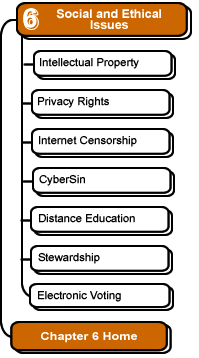

Intellectual Property
|
The failure to meet conventional technical criteria did not propel Pentium III, Napster, and data mining into the limelight—the controversial ways these technologies engaged social, ethical, and political values did that. Helen Nissenbaum, "How Computer Systems Embody Values," Computer 34, no. 3 (March 2001): 118. |
Intellectual property rights are legal entitlements given to the creators of artistic works, granting them exclusive legal discretion in how their work is used, including the right to duplicate it or to charge a monetary fee for use. For example, the authors of novels have a copyright on their work, which gives them the right to make copies or to sell the novel to a publisher. Composers of songs hold a similar copyright. Inventors can obtain a patent on an invention, allowing them to collect royalties from companies that wish to sell a product that uses the idea of the patent. These legal rights, as well as limitation to them (in time and scope) are embedded in national and international intellectual property rights law.
In the past, violators of intellectual property rights law faced several hurdles:
- reproducing an artistic work was expensive. Photocopying an entire novel sometimes cost more than simply buying a legal copy from a bookstore
- reproductions were usually inferior. A copy of an audio- or videotape is never as good as the original, and each generation of copies decreases in quality
- it was difficult to distribute illegal copies without getting caught
Information technology has cleared many of these hurdles and added new twists to the legal questions of intellectual property rights. Many related laws are being reexamined and modified to deal with issues regarding information technology. Why has information technology changed the legal landscape?
- artistic works such as books and audio- or videotapes can be digitized easily, and copies of the digital data can be made inexpensively
- a digital copy of a digital work is a perfect replica of the original
- digital reproductions can be distributed anonymously and in large quantities over the Internet
Note that copied digital data is a perfect replica of the original digital data, but not of the original work itself—unless the original was digital to begin with. For example, a painting can be digitized into a computer image, but when printed it will not have the original's texture, smell, or feel. In addition, in order to save space (or bandwidth), digital art collectors often use compression techniques that are "lossy," meaning the digital data loses some small amount of information (the trade-off is a much smaller file). For example, an MP3 music file or a JPEG image file might be ten times smaller than the original source data, but it may also suffer at least 10% loss in quality. Of course, as computer memory and bandwidth become larger and cost less, data size is not as big an issue.
Here are some specific examples:
- Digital Music (Napster, mp3.com lawsuits)
- Digital Images (JPEG images and digital watermarks)
![]()
![]()
These pages were written by Steven H. VanderLeest and Jeffrey Nyhoff and edited by Nancy Zylstra
©2005 Calvin University (formerly Calvin College), All Rights Reserved
If you encounter technical errors, contact computing@calvin.edu.